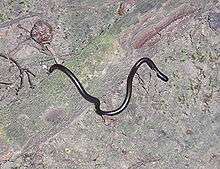Leptotyphlops
Leptotyphlops is a genus of nonvenomous blind snakes, commonly known as slender blind snakes and threadsnakes,[2] in the family Leptotyphlopidae. The genus is endemic to and found throughout Africa. 11 species have been moved to the genus Trilepida, and other species have been moved to the genera Epacrophis, Epictia, Mitophis, Myriopholis, Namibiana, Rena, Siagonodon, Tetracheilostoma, and Tricheilostoma.
| Leptotyphlops | |
|---|---|
 | |
| Peters's threadsnake (L. scutifrons) | |
| Scientific classification | |
| Kingdom: | Animalia |
| Phylum: | Chordata |
| Class: | Reptilia |
| Order: | Squamata |
| Suborder: | Serpentes |
| Family: | Leptotyphlopidae |
| Genus: | Leptotyphlops Fitzinger, 1843 |
| Synonyms[1] | |
| |
Description
Most species of Leptotyphlops look much like shiny earthworms. They are pink or brown, and their scales give them a segmented appearance. Other species are black in color, but have the same general body structure. Their common name comes from the fact that their eyes are greatly reduced almost to the point of uselessness, and hidden behind a protective head scale. The species which are called thread snakes are so named because of their very narrow, long bodies.
Behavior
All blind snakes including those of the genus Leptotyphlops are burrowing snakes, spending most of their time deep in loose soil, typically only emerging when it rains and they get flooded out.
Species
| Species[2] | Taxon author[2] | Subsp.*[2] | Common name | Geographic range |
|---|---|---|---|---|
| Leptotyphlops aethiopicus[3] | Broadley & Wallach, 2007 | |||
| Leptotyphlops conjunctus | (Jan, 1861) | 3 | Cape thread snake | |
| Leptotyphlops distanti | (Boulenger, 1892) | 0 | Distant's blind snake | |
| Leptotyphlops emini | (Boulenger, 1890) | 0 | Emin Pasha's worm snake | |
| Leptotyphlops howelli [3] | Broadley & Wallach, 2007 | |||
| Leptotyphlops incognitus[3] | Broadley & Watson, 1976 | |||
| Leptotyphlops jacobseni [3] | Broadley & S. Broadley, 1999 | |||
| Leptotyphlops kafubi [3] | (Boulenger, 1919) | |||
| Leptotyphlops keniensis[3] | Broadley & Wallach, 2007 | |||
| Leptotyphlops latirostris[3] | (Sternfeld, 1912) | |||
| Leptotyphlops macrops | Broadley & Wallach, 1996 | 0 | goggle-eyed worm snake | |
| Leptotyphlops mbanjensis[3] | Broadley & Wallach, 2007 | |||
| Leptotyphlops merkeri [3] | (F. Werner, 1909) | |||
| Leptotyphlops nigricansT | (Schlegel, 1839) | 0 | black thread snake | |
| Leptotyphlops nigroterminus[3] | Broadley & Wallach, 2007 | |||
| Leptotyphlops pembae[3] | Loveridge, 1941 | |||
| Leptotyphlops pitmani [3] | Broadley & Wallach, 2007 | |||
| Leptotyphlops pungwensis[3] | Broadley & Wallach, 1997 | |||
| Leptotyphlops scutifrons | (W. Peters, 1854) | 0 | Peters's thread snake | |
| Leptotyphlops sylvicolus[3] | Broadley & Wallach, 1997 | |||
| Leptotyphlops telloi | Broadley & Watson, 1976 | 0 | Tello's thread snake |
- |
*) Not including the nominate subspecies.
T) Type species.
References
- McDiarmid RW, Campbell JA, Touré TA (1999). Snake Species of the World: A Taxonomic and Geographic Reference, Volume 1. Washington, District of Columbia: Herpetologists' League. 511 pp. ISBN 1-893777-00-6 (series). ISBN 1-893777-01-4 (volume).
- "Leptotyphlops". Integrated Taxonomic Information System. Retrieved 29 August 2007.
- "Leptotyphlops" . The Reptile Database. www.reptile-database.org.
External links
| Wikispecies has information related to Leptotyphlops |
| Wikimedia Commons has media related to Leptotyphlops. |
- Leptotyphlops at the Reptarium.cz Reptile Database. Accessed 29 August 2007.